+ Open data
Open data
- Basic information
Basic information
| Entry | Database: PDB / ID: 2zhc | ||||||
|---|---|---|---|---|---|---|---|
| Title | ParM filament | ||||||
 Components Components | Plasmid segregation protein parM | ||||||
 Keywords Keywords | CELL CYCLE/PROTEIN FIBRIL / ParM / Plasmid / Plasmid partition / CELL CYCLE-PROTEIN FIBRIL COMPLEX | ||||||
| Function / homology |  Function and homology information Function and homology information | ||||||
| Biological species |  | ||||||
| Method | ELECTRON MICROSCOPY / helical reconstruction / negative staining / Resolution: 23 Å | ||||||
 Authors Authors | Popp, D. / Narita, A. / Oda, T. / Fujisawa, T. / Matsuo, H. / Nitanai, Y. / Iwasa, M. / Maeda, K. / Onishi, H. / Maeda, Y. | ||||||
 Citation Citation |  Journal: EMBO J / Year: 2008 Journal: EMBO J / Year: 2008Title: Molecular structure of the ParM polymer and the mechanism leading to its nucleotide-driven dynamic instability. Authors: David Popp / Akihiro Narita / Toshiro Oda / Tetsuro Fujisawa / Hiroshi Matsuo / Yasushi Nitanai / Mitsusada Iwasa / Kayo Maeda / Hirofumi Onishi / Yuichiro Maéda /  Abstract: ParM is a prokaryotic actin homologue, which ensures even plasmid segregation before bacterial cell division. In vivo, ParM forms a labile filament bundle that is reminiscent of the more complex ...ParM is a prokaryotic actin homologue, which ensures even plasmid segregation before bacterial cell division. In vivo, ParM forms a labile filament bundle that is reminiscent of the more complex spindle formed by microtubules partitioning chromosomes in eukaryotic cells. However, little is known about the underlying structural mechanism of DNA segregation by ParM filaments and the accompanying dynamic instability. Our biochemical, TIRF microscopy and high-pressure SAX observations indicate that polymerization and disintegration of ParM filaments is driven by GTP rather than ATP and that ParM acts as a GTP-driven molecular switch similar to a G protein. Image analysis of electron micrographs reveals that the ParM filament is a left-handed helix, opposed to the right-handed actin polymer. Nevertheless, the intersubunit contacts are similar to those of actin. Our atomic model of the ParM-GMPPNP filament, which also fits well to X-ray fibre diffraction patterns from oriented gels, can explain why after nucleotide release, large conformational changes of the protomer lead to a breakage of intra- and interstrand interactions, and thus to the observed disintegration of the ParM filament after DNA segregation. | ||||||
| History |
|
- Structure visualization
Structure visualization
| Movie |
 Movie viewer Movie viewer |
|---|---|
| Structure viewer | Molecule:  Molmil Molmil Jmol/JSmol Jmol/JSmol |
- Downloads & links
Downloads & links
- Download
Download
| PDBx/mmCIF format |  2zhc.cif.gz 2zhc.cif.gz | 117.1 KB | Display |  PDBx/mmCIF format PDBx/mmCIF format |
|---|---|---|---|---|
| PDB format |  pdb2zhc.ent.gz pdb2zhc.ent.gz | 89.7 KB | Display |  PDB format PDB format |
| PDBx/mmJSON format |  2zhc.json.gz 2zhc.json.gz | Tree view |  PDBx/mmJSON format PDBx/mmJSON format | |
| Others |  Other downloads Other downloads |
-Validation report
| Summary document |  2zhc_validation.pdf.gz 2zhc_validation.pdf.gz | 796.6 KB | Display |  wwPDB validaton report wwPDB validaton report |
|---|---|---|---|---|
| Full document |  2zhc_full_validation.pdf.gz 2zhc_full_validation.pdf.gz | 798.4 KB | Display | |
| Data in XML |  2zhc_validation.xml.gz 2zhc_validation.xml.gz | 12.2 KB | Display | |
| Data in CIF |  2zhc_validation.cif.gz 2zhc_validation.cif.gz | 18.9 KB | Display | |
| Arichive directory |  https://data.pdbj.org/pub/pdb/validation_reports/zh/2zhc https://data.pdbj.org/pub/pdb/validation_reports/zh/2zhc ftp://data.pdbj.org/pub/pdb/validation_reports/zh/2zhc ftp://data.pdbj.org/pub/pdb/validation_reports/zh/2zhc | HTTPS FTP |
-Related structure data
| Related structure data |  1470MC 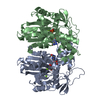 2zgyC 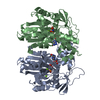 2zgzC M: map data used to model this data C: citing same article ( |
|---|---|
| Similar structure data |
- Links
Links
- Assembly
Assembly
| Deposited unit | 
|
|---|---|
| 1 |
|
- Components
Components
| #1: Protein | Mass: 35804.375 Da / Num. of mol.: 1 Source method: isolated from a genetically manipulated source Source: (gene. exp.)   |
|---|---|
| #2: Chemical | ChemComp-MG / |
| #3: Chemical | ChemComp-ADP / |
-Experimental details
-Experiment
| Experiment | Method: ELECTRON MICROSCOPY |
|---|---|
| EM experiment | Aggregation state: FILAMENT / 3D reconstruction method: helical reconstruction |
- Sample preparation
Sample preparation
| Component | Name: ParM filament / Type: COMPLEX / Details: stained with 1.0 % uranyl acetate |
|---|---|
| Buffer solution | Name: 10mM Hepes, 25mM KCl, 1mM MgCl2, 1mM DTT, 5mM GMPPNP / pH: 7.5 Details: 10mM Hepes, 25mM KCl, 1mM MgCl2, 1mM DTT, 5mM GMPPNP |
| Specimen | Conc.: 0.13 mg/ml / Embedding applied: NO / Shadowing applied: NO / Staining applied: YES / Vitrification applied: NO |
| EM staining | Type: NEGATIVE / Material: Uranyl Acetate |
| Specimen support | Details: Carbon |
- Electron microscopy imaging
Electron microscopy imaging
| Microscopy | Model: JEOL 2010HC / Date: Jan 1, 2007 |
|---|---|
| Electron gun | Electron source: LAB6 / Accelerating voltage: 100 kV / Illumination mode: FLOOD BEAM |
| Electron lens | Mode: BRIGHT FIELD / Nominal magnification: 40000 X / Nominal defocus max: 10300 nm / Nominal defocus min: 3700 nm |
| Specimen holder | Temperature: 300 K / Tilt angle max: 0 ° / Tilt angle min: 0 ° |
| Image recording | Electron dose: 12 e/Å2 / Film or detector model: GENERIC FILM |
| Image scans | Num. digital images: 2085 |
| Radiation | Protocol: SINGLE WAVELENGTH / Monochromatic (M) / Laue (L): M |
| Radiation wavelength | Relative weight: 1 |
- Processing
Processing
| EM software | Name: EOS / Category: 3D reconstruction | ||||||||||||
|---|---|---|---|---|---|---|---|---|---|---|---|---|---|
| CTF correction | Details: Phase and Amplitude | ||||||||||||
| 3D reconstruction | Method: Single particle analysis / Resolution: 23 Å / Num. of particles: 2085 / Nominal pixel size: 4.011 Å / Actual pixel size: 4.011 Å Details: This data was achieved by negative staining experiments Symmetry type: HELICAL | ||||||||||||
| Atomic model building | PDB-ID: 1MWM Accession code: 1MWM / Source name: PDB / Type: experimental model | ||||||||||||
| Refinement | Highest resolution: 23 Å Details: This data was achieved by negative staining experiments | ||||||||||||
| Refinement step | Cycle: LAST / Highest resolution: 23.8 Å
|
 Movie
Movie Controller
Controller



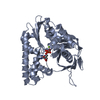
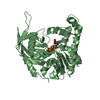
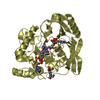
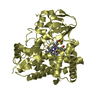

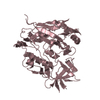
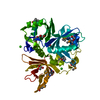
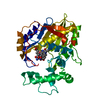
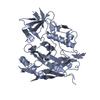
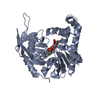

 PDBj
PDBj



